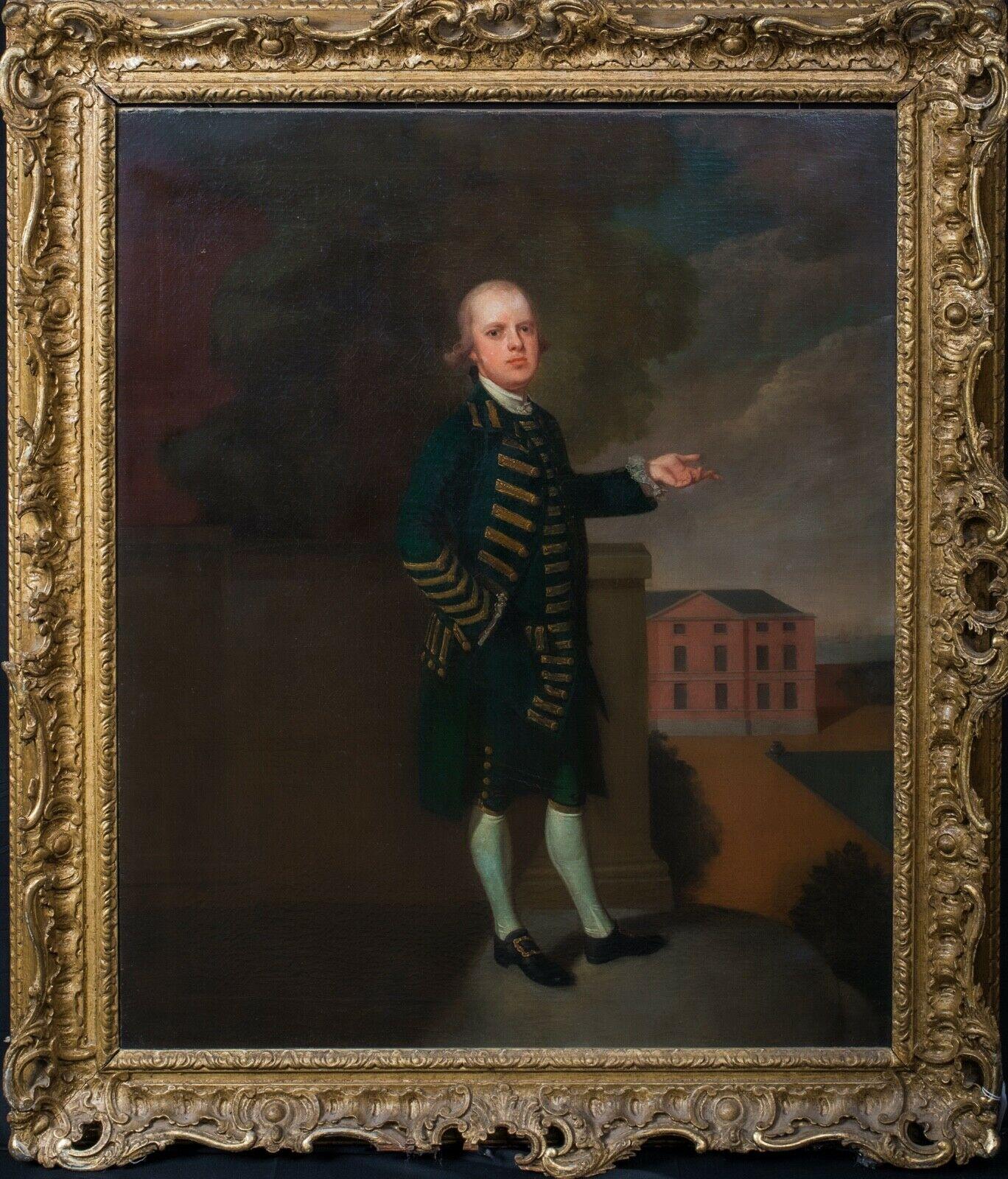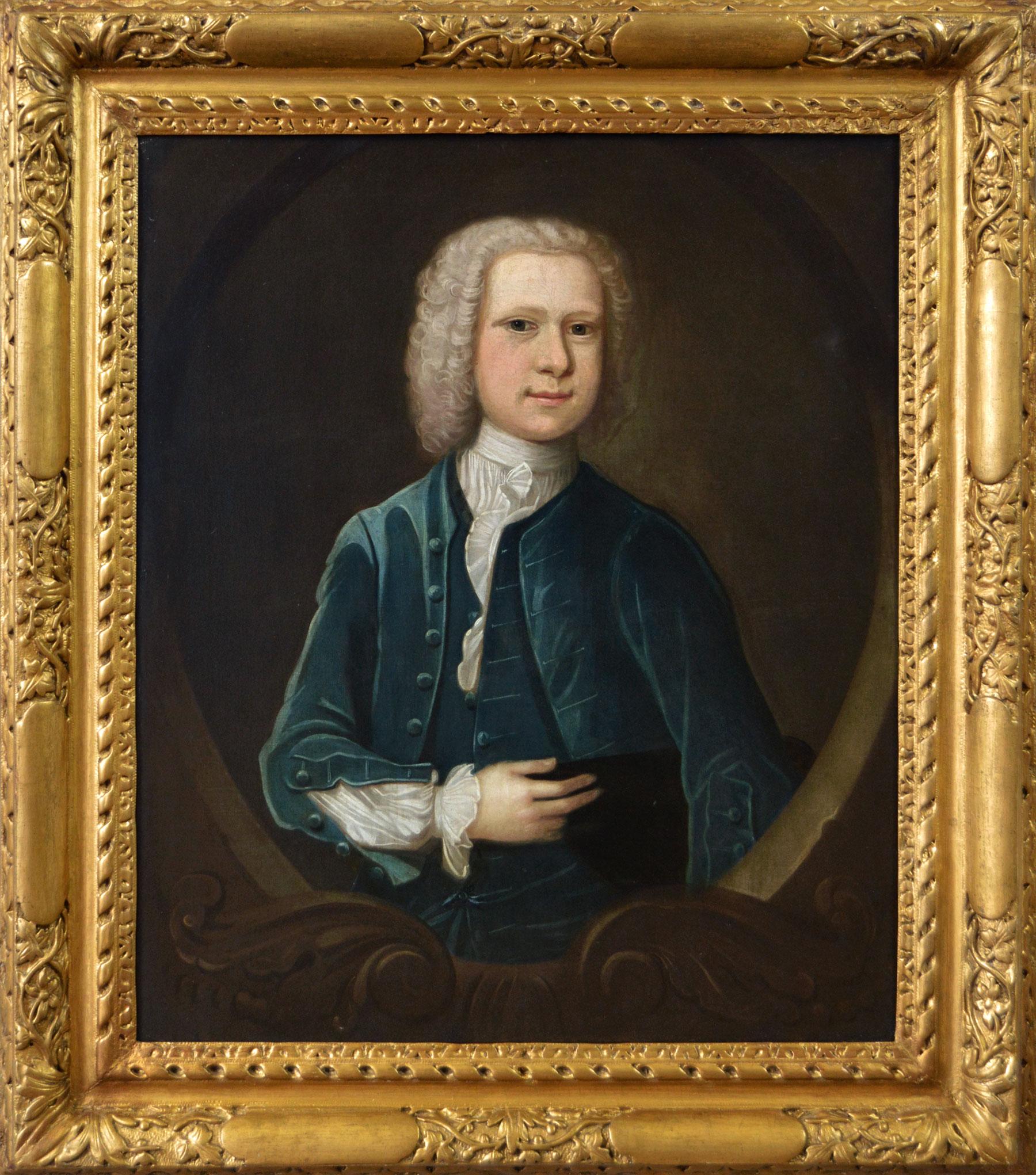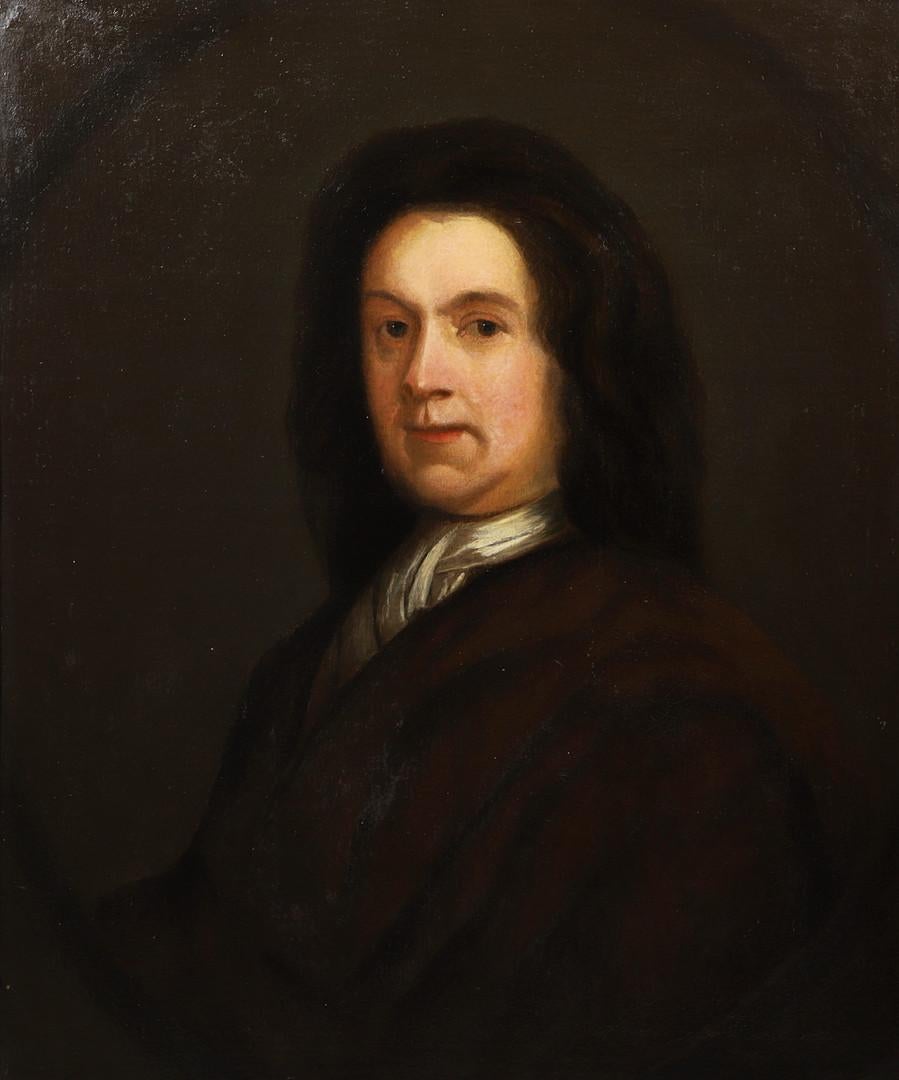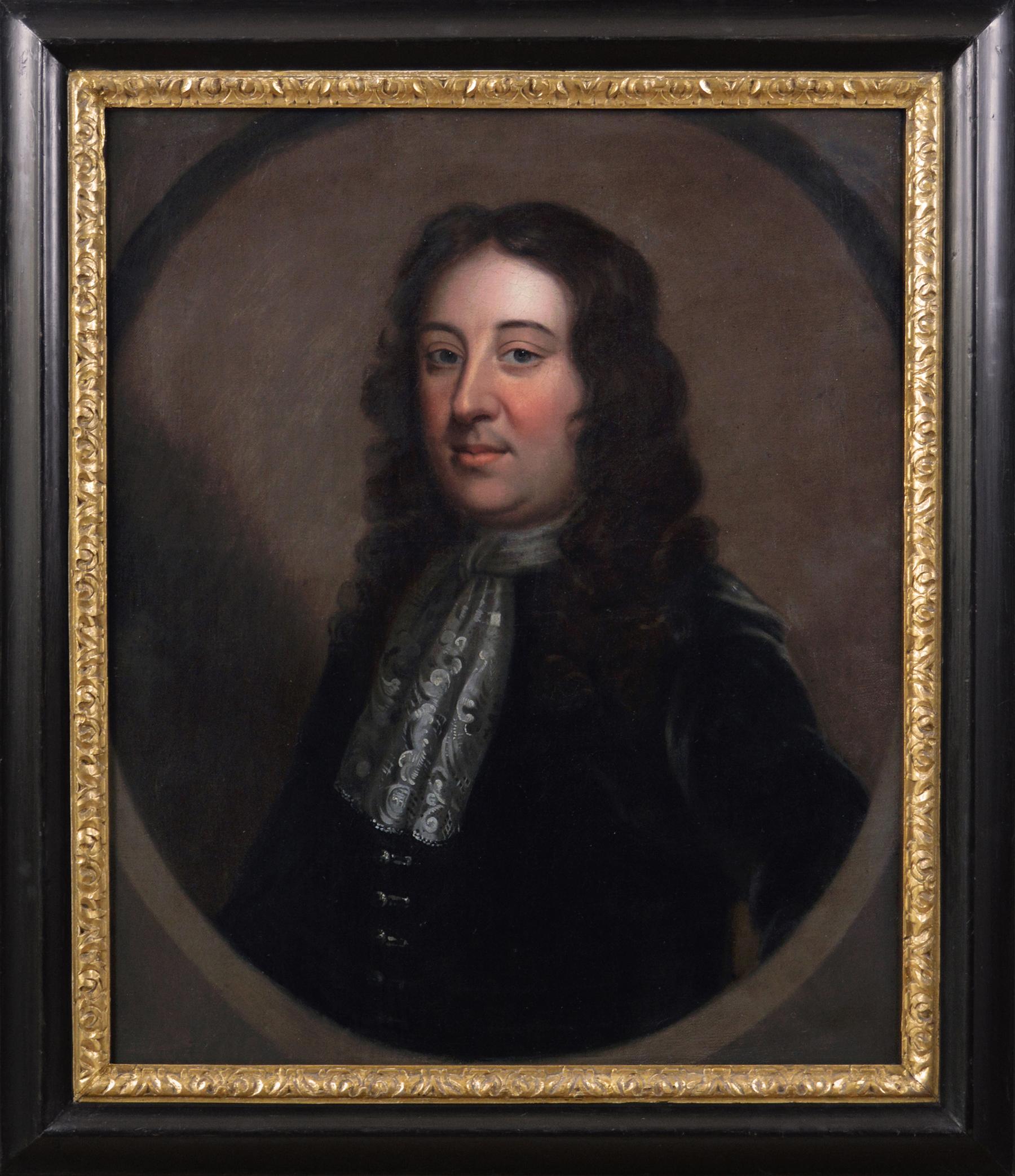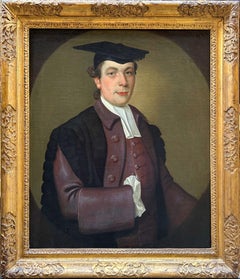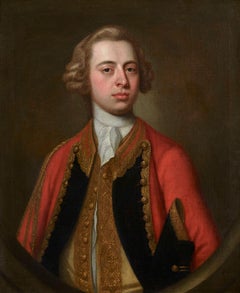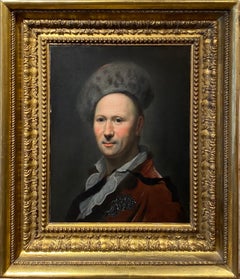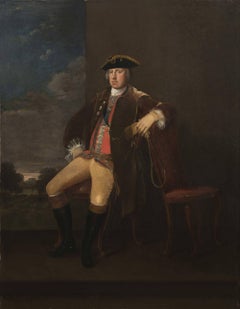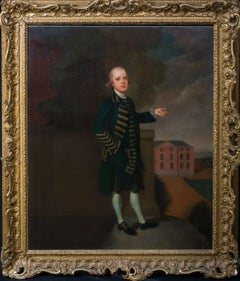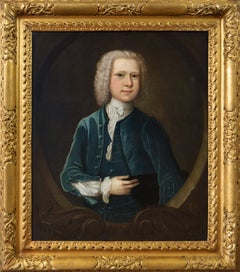Items Similar to Portrait of a Gentleman, 18th Century Oil Painting
Want more images or videos?
Request additional images or videos from the seller
1 of 5
Anton von MaronPortrait of a Gentleman, 18th Century Oil Painting
$42,062.49
£30,000
€35,644.81
CA$57,403.23
A$63,923.67
CHF 33,268.74
MX$788,171.17
NOK 423,702.84
SEK 398,239.60
DKK 265,954.49
Shipping
Retrieving quote...The 1stDibs Promise:
Authenticity Guarantee,
Money-Back Guarantee,
24-Hour Cancellation
About the Item
Oil on canvas
Image size: 20 x 24 inches (51 x 61 cm)
Period gilt frame
This is a half-length portrait of a gentleman wearing a emerald coat and intricately designed waistcoat, dated to circa 1760.
This impressive portrait was created by one of the more interesting of the many foreign painters working in Rome in the second half of the 18th century. It is notable for its striking luminosity of bold colour and the realistic depiction of fabrics such as the remarkable treatment of the lace that has been painstakingly rendered. The emerald coat is remarkable with its embroidered and expensive buttons. He is wearing a stock around his neck, which is a folded cloth fastened at the back, and a lace ruffle attached to the front of his shirt, with matching sleeve ruffles. The hand we can see is neatly tucked into his coat. This is a traditional symbol of gentility and social status in portraits.
The Artist
Anton von Maron was an Austrian painter, mainly active in Rome. Von Maron was born in Vienna, but moved at a young age to Rome and settled there in 1755. Here he became a member of the Accademia di San Luca in 1766 and later a Director in 1784.
In Rome he studied under Anton Raphael Mengs and became his pupil and assistant. He had ambitions as a history painter but worked mainly as a portraitist, in a style similar - indeed sometimes deceptively close - to Batoni's. Like Batoni, he painted many wealthy British visitors to Rome and for most of his career he was successful and respected. He received a huge number of commissions from princes, diplomats and Church dignitaries, and English aristocrats visiting Rome on their Grad Tour.
He married a sister of Mengs, Therese Mengs, who was a painter in her own right. He lived the rest of his life in Rome and died there in 1808.
About the Seller
5.0
Vetted Professional Seller
Every seller passes strict standards for authenticity and reliability
Established in 2007
1stDibs seller since 2014
81 sales on 1stDibs
Typical response time: 3 hours
- ShippingRetrieving quote...Shipping from: London, United Kingdom
- Return Policy
Authenticity Guarantee
In the unlikely event there’s an issue with an item’s authenticity, contact us within 1 year for a full refund. DetailsMoney-Back Guarantee
If your item is not as described, is damaged in transit, or does not arrive, contact us within 7 days for a full refund. Details24-Hour Cancellation
You have a 24-hour grace period in which to reconsider your purchase, with no questions asked.Vetted Professional Sellers
Our world-class sellers must adhere to strict standards for service and quality, maintaining the integrity of our listings.Price-Match Guarantee
If you find that a seller listed the same item for a lower price elsewhere, we’ll match it.Trusted Global Delivery
Our best-in-class carrier network provides specialized shipping options worldwide, including custom delivery.More From This Seller
View AllPortrait of a Gentleman Commoner at Oxford, 18th Century Oil on Canvas
By James Northcote b.1746
Located in London, GB
James Northcote
Portrait of a Gentleman Commoner at Oxford
Oil on canvas
Image size: 30 x 25 inches (76 x 63.5 cm)
Original gilt frame
This painting is a comparatively rare example ...
Category
18th Century English School Portrait Paintings
Materials
Canvas, Oil
Portrait of William Henry Kerr, Earl of Ancram, 4th Marquess of Lothian
Located in London, GB
James Fellowes
Flourished 1719 - 1750
Portrait of William Henry Kerr, Earl of Ancram, 4th Marquess of Lothian
Oil on canvas, signed & dated 1747
Image size: 29 1/2 x 24 1/2 inches (75 x 62 cm)
Original gilt wood frame
William Henry Kerr was born a member of the Scottish peerage to William, third Marquess of Lothian, and his first wife Margaret, daughter of Sir Thomas Nicholson of Kemnay, first Baronet. William was styled Master Jedburgh until 1722, when his father was elevated to a Marquessate, after which he was referred to as Lord Jedburgh until 1735. Following his father’s military footsteps, on 20 June 1735 Ancram was commissioned as a cornet to the regiment (11th Dragoons) of his grand-uncle, Lord Mark Kerr. Ancram married Lady Caroline...
Category
1740s Old Masters Portrait Paintings
Materials
Oil
Portrait of Conrad Friedrich Hurlebusch, Early 18th Century Oil Painting
By Dominicus van der Smissen
Located in London, GB
Dominicus van der Smissen
Early 18th Century
Portrait of Conrad Friedrich Hurlebusch
Oil on canvas
Image size: 20½ x 16¼ inches
Period gilt frame
This is a portrait of Conrad Friedrich Hurlebusch, composer, Kapellmeister and organist, whom Van der Smissen most probably portrayed during his stay in Hamburg, Brunswick or Amsterdam. The identification is based on the reproduction of the portrait which was engraved by Pieter Anthony Wakkerdak (1740- 1774).
Van der Smissen has reduced the face of the sitters to an egg-shaped oval in three-quarter view, applying diminution to one half of the figure’s torso, which is farther away from the viewer. This partial side view, with the head turned to look at the viewer over the shoulder, creates spatial depth and brings the figure to life by avoiding the stiffness of a frontal depiction.
Because the artist chose to highlight the figure from above, a distinct shadow is cast under the tip of the nose, in the shape of a triangle. This is an often recurring and almost ‘signature’-like feature in Van der Smissen’s oeuvre.
Hurlebusch's garments are of a very high quality and serve to reflect the sitter’s wealth, status and elegance. During this period, gentlemen often shaved their heads in order to facilitate the wearing of a wig, which wouldbe worn with a suit. Here Hurlebusch has been depicted in a luxurious turban-like cap lined with lynx fur, a highly fashionable and expensive material at the time.
Over his shirt, he wears a velvet fur-lined gown adorned with decorative clasps fashioned from silver braid. The elegant informality of his appearance can be seen in his unbuttoned shirt and the unfastened black ribbon hanging from his button hole, which has been artfully arranged into a fluttering drape by the portraitist.
The Sitter
Hurlebusch was born in Brunswick, Germany. He received the first instructions in his field from his father Heinrich Lorenz Hurlebusch, who was also a musician. As an organ virtuoso, he toured Europe, visiting Vienna, Munich and Italy.
From 1723 to 1725 he was Kapellmeister in Stockholm; later he became Kapellmeister in Bayreuth and Brunswick, and lived in Hamburg from 1727 to 1742, where he had contact with fellow composers Johann Mattheson and Georg Philipp Telemann. He made his living composing, performing and teaching.
In 1735 and 1736, he is believed to have visited Johann Sebastian Bach in Leipzig, who promoted Hurlebusch’s compositions as the local seller...
Category
Early 18th Century Old Masters Portrait Paintings
Materials
Canvas, Oil
Portrait of a King's Messenger, 18th Century English Artist, Original Frame
By Charles Philips
Located in London, GB
Charles Philips
1703 - 1747
Portrait of a King's Messenger
Oil on canvas
Image size: 35 ¾ x 28 inches
Original gilt frame
King's Messenger
The job of a King's Messenger was that of a diplomatic courier, hand-carrying important and secret documents around the world. Some say that the history of the sovereigns' messengers goes back to 1199, but the first known messenger was John Norman, who in 1485 earned 4d (1½ pence) per day for carrying the state papers of Richard III.
The silver greyhound on the messenger's badge dates back to Charles II. In 1660, during his exile at Breda, Netherlands, Charles II issued a declaration of amnesty to all those who had opposed him and his father. He used messengers to make his intentions known. In answer to the messenger's question "How will they know me?", Charles reached forward to a silver bowl on the table in front of him. This bowl, with four decorative greyhounds standing proud above the rim, was well known to all courtiers. Charles broke off a greyhound and gave it to the messenger as a guarantee that the message came from him. From that date, the King's Messenger always wore a silver greyhound around his neck.
Later, dating from George II or III, a badge with the Royal Arms in enamel, with the greyhound suspended beneath, was worn. A George III example of the King's Messenger Badge, pre 1800, sold for over £30,000 pounds some years ago.
The silver greyhounds were minted for each new reign, except the brief one of King Edward VIII. The sovereign's messengers were originally controlled by the Lord Chamberlain, being Messengers of the Great Chamber. When the Foreign Office was created in 1782, the messengers remained common to the three Secretaries of State.
Charles Philips was an English artist known for painting a number of portraits and conversation pieces for noble and Royal patrons in the mid-eighteenth century.
Philips was baptised in the combined parish of St Mildred, Poultry with St Mary...
Category
18th Century Portrait Paintings
Materials
Canvas, Oil
Portrait of Ralph William Grey
By Bartholomew Dandridge
Located in London, GB
Provenance
By descent through the sitter's family to
The Collection of R. W. Vivian-Neal of Poundisford Park, Somerset, from whom acquired by
With Lane Fine Art, UK, where purchased by the present owners in 1996
Literature
'Poundisford Park, Somerset' in Country Life, 22 December 1934, ill.
A.W. and C.M. Vivian-Neal, Poundisford Park, Somerset: A catalogue of pictures and furniture, Taunton 1939, cat. nos. 11 and 13
This is a three-quarter-length portrait of Ralph William Grey in a mole-coloured velvet coat and a long waistcoat of green satin, heavily embroidered in gold. Under his left right hand is a black chapeau bras. He has white doe-skin gauntlet gloves.
Son of William and Ann Grey of Backworth: born 19 December 1707. He married Mary the daughter of William Rawstorne of Newall in 1741 and died 5 November 1786. He was educated at Eaton and Trinity College, Oxford.
Within a year of his birth Mrs Grey died and, according to the Country Life article 'From that time forward all Mr Grey's faculties were concentrated on the well-being of his son. The possession of an heir gave zest to his efforts to build up the family fortune: he was successful in most of his ventures. Years later his interest in life was centred in the home of his daughter-in-law and grandchildren'.
Grey's right hand is depicted in the present portrait resting on Locke's Essays and the Country Life article also records that there are constant references to John Locke...
Category
Mid-18th Century English School Portrait Paintings
Materials
Oil
Portrait of a Man with a Rifle
Located in London, GB
Oil on layered paper
Image size: 10 1/2 x 8 1/4 inches (26.5 x 21 cm)
Contemporary swept frame
This is an eighteenth century portrait of a...
Category
Late 18th Century Naturalistic Figurative Paintings
Materials
Oil, Laid Paper
You May Also Like
Portrait Of A Gentleman & His Estate, Attributed to Arthur Devis, 18th Century
By Arthur Devis
Located in Blackwater, GB
Portrait Of A Gentleman & His Estate, 18th Century
attributed to Arthur DEVIS (1712-1787)
One of a matching pair - the other is believed to be the brother
Large 18th century Eng...
Category
18th Century English School Portrait Paintings
Materials
Canvas, Oil
$9,534 Sale Price
20% Off
18th Century portrait oil painting of a gentleman
Located in Nr Broadway, Worcestershire
Follower of Enoch Seeman the Younger
German, (1694-1744)
Portrait of Gilbert Sympkin
Oil on canvas
Image size: 29.25 inches x 24.5 inches
Size including frame: 38 inches x 33.25 inches
A fine three quarter length portrait of a gentleman traditionally identified as Gilbert Simpkin (Sympkin), follower of Enoch Seeman the younger, C1720. The portrait is set in a feigned sculptured oval cartouche, a device used to give a sense of depth. The sitter is depicted wearing a fashionable blue jacket and matching waistcoat with a white chemise and lace jabot. He wears a powdered wig in the fashionable style of the day and is posed holding his hat under his left arm with the fingers of his right hand stretched out. At court, long fingers signified wealth, culture and intelligence. The painting has clearly been executed by an artist of great ability who has been influenced by Enoch Seeman the younger.
Gilbert Simpkin (Sympkin) was born in London on 24 August 1683, the son of John Simpkin and Susannah Butler. His grandfather was also called Gilbert Simpkin. He entered Oxford University in 1700 where he studied at St John’s College. In 1702, he became a student of Middle Temple, which at the time was one of the world’s most important centres of legal education. He later settled in Plymouth and then Bristol. He died in Bristol on 15 May, 1744 and was buried at Bristol Cathedral. He remained unmarried and the portrait may well have been commissioned to commemorate when he was first Called to the Bar or perhaps had established his own practice.
Enoch Seeman or Seemann the younger was born in Danzig, Germany now Gdansk, Poland in 1694. His father was Enoch Seeman Senior, an artist of Flemish origin and his brothers Isaac, Noah and Abraham also became artists. He came to London with his father and brothers around 1704 and established himself as a portrait artist. From 1717 he became painter to the Royal court painting...
Category
18th Century Old Masters Portrait Paintings
Materials
Canvas, Oil
large 18th century portrait gentleman oil on canvas
Located in York, GB
A fine, imposing 18th century portrait of an unknown aristocrat,housed in a gilt frame
The artist is also unidentified but certainly a talented hand, in the circle of one of the fine old masters of the period
The size overall is 148 x 121 cm whilst the painting is 128 x 101 cm
In overall good condition the frame at the bottom has bowed slightly
The painting has been checked whilst being cleaned and has not been affected in any way .
SHIPPING
Free delivery to mainland uk ,worldwide shipping available please email for quote
Delivery usually within 14 working days, insured
please provide telephone/email details for courier.
All taxes/customs etc to be paid for by purchaser.
RETURNS (The Consumer Contracts Regulations) Whilst we are sure that you will be extremely happy with your purchase,
if for any reason you are not, then you are entitled to return the item to us for a refund.
For all purchases made
you are entitled to return the item(s) for a period of up to 14 days
following receipt by you or a representative indicated by you.
Please contact us to confirm that you are returning the item(s)
and the reason for doing so.
Upon receipt of the item(s) we will refund the purchase price via your original payment method...
Category
18th Century Old Masters Portrait Paintings
Materials
Oil
$7,707 Sale Price
44% Off
Free Shipping
Old Master Portrait of a Gentleman - British 18th century oil painting
By Michael Dahl
Located in London, GB
This stunning 18th century Old Master portrait oil painting is attributed to Swedish born, England based artist Michael Dahl. Painted circa 1690 it is a sumptuous half length portrai...
Category
17th Century Old Masters Portrait Paintings
Materials
Oil
$10,655 Sale Price
20% Off
Fine Large 17th/ 18th Century English Portrait of Mr. Gilbert Charity Founder
Located in Cirencester, Gloucestershire
Portrait of Mr. Gilbert (believed to be the founder of 'Gilberts Charity, Bridgwater, Somerset)
English School artist, late 17th/ early 18th century
oil...
Category
Late 17th Century Old Masters Portrait Paintings
Materials
Oil, Canvas
17th Century portrait oil painting of a gentleman
By John Riley
Located in Nr Broadway, Worcestershire
Circle of John Riley
British, (1646-1691)
Portrait of a Gentleman
Oil on canvas
Image size: 29 inches x 24 inches
Size including frame: 36 inches x 31 inch...
Category
17th Century Old Masters Portrait Paintings
Materials
Canvas, Oil
More Ways To Browse
Antique Hand Paint Portrait
18th Century Embroidered
Vienna 18th
18th Century Lace
Hand Painted Buttons
18th Century Waistcoat
Andy Warhol Endangered Species
Annie Leibovitz Patti Smith
Antique Ballet Slippers
Antique Felix The Cat
Anton Weiss
Arader Gallery
Ark Of The Covenant
Armand Fouquet
Arte Povera Poster
Atelier Populaire
Audubon Rabbit
Auguste H Thomas
